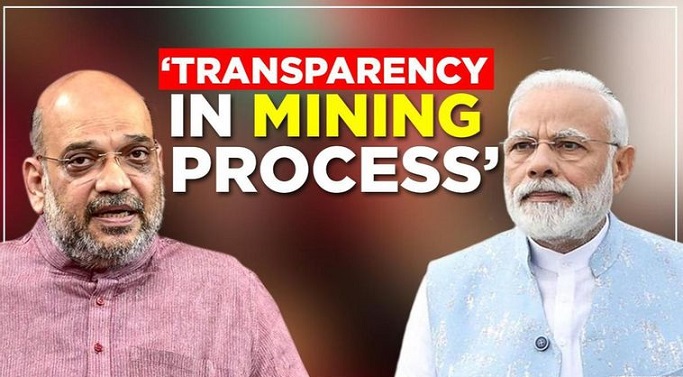By Anurjay Dhal
BHUBANESWAR: With a view to analyse the impact and efficacy of the auction of mineral resources, the Federation of Indian Mineral Industries (FIMI)has undertaken an in-depth study entitled “Auction of Mineral Resources -– An Anatomy”. “Auction regime has put the nation back by one generation with uncertain future for the growth of country’s mineral resources and continued dependence on ever-increasing imports. Auction did not also prove to be as transparent or fair as was thought.,” FIMI said.
“ Therefore, it is high time for India to deliberate whether auction is the right policy instrument for mineral development. Can auction lead to increased mineral production, with focus on deep-seated minerals to reduce import dependency, promote global competitiveness and generate employment opportunities across the mining value chain?,” FIMI said in an exclusive report on Tuesday, copy of which is available with www.indianewsdiary.com.
“No doubt, the States got revenues (though below the expectation, at the cost of production and job losses and absence of socio-economic development), but the nation lost in terms of ever-increasing imports and massive foreign exchange outgo. Auction is an unnecessarily costly way of developing mineral resources. Unsustainably high cost of raw materials is leading to reduced competitiveness of not just mining sector, but all downstream industries, with serious repercussions for ‘Make in India’ initiative. Auction has neither served public good nor led to fair allocation of resources. The sole focus to maximize revenues for the States has adversely affected long-term mineral development in the country and socio-economic benefits in mining areas,” FIMI said.
India introduced auction for its coal resources in 2010 and for its non-coal resources in2015 through amendments in the MMDR Act, 1957. Ever since, auction has been hailed as apanacea for all that were coming in the way of resource development. It was acclaimed to be a fair and transparent mechanism to allocate resources, which would encourage competition and generate huge revenues for the State Governments through resource development, it said.
The New Delhi Headquarters’, FIMI said , it was thought that “auction” system will bring transparency and lead to resource development. As per the study brought out by FIMI, the “auction” has neither brought transparency nor expected revenues to the States. Rather the system has brought scare among the consumers / industries about the availability of raw materials which led to high and unsustainable bids, costly raw materials, making the industries unviable, leading to their imports, and foreign exchange out-go. Not only this, not a single greenfield mining project – coal or non-coal – has come into operation. The country continues to import more and more coal and other metals.
Auction has even halted operation in previously working mines having valid environment and forest clearances (EC and FC). This has resulted in production and job losses, upsetting the socio-economic life of people of the areas where working mines were closed down. For few mines which could start, auction has become a winner’s curse. Auction of Coal Mines:
Before auction, 37 coal mines were operational, after auctioned/allotted only 20 coal mines have come into operation. Auction has not only made the operational mines unviable / difficult to operate, but also reduced the total coal production from these mines from 42.88 million tonnes in 2014-15 to 30.04 million tonnes in 2018-19.
Generating more revenues for the exchequer has been one of the prime objectives for auction of coal blocks. After auction / allotment, State Governments were able to gain more revenues, i.e. Rs. 2025.61 crores in 2018-19. However, auction / allotment resulted in production loss to the tune of 12.84 million tonnes in 2018-19 in comparison to the year 2014- 15, which had to be compensated through imports worth Rs. 5319.74 crores. Thus, the nation’s expenditure on imports was 2.63 times than the revenue generated through coal auction, it said.
In case of commercial coal blocks auction, which happened recently on June 18, 2020, out of 19 coal blocks auctioned, 17 blocks are fully explored (4 previously operational / under advanced stage of operation) and 2 blocks are partially explored. These 19 auctioned coal blocks expected to produce around 51 million tonnes per annum at their peak rated capacity.However, there would be no substantial increase in total coal production immediately because of the fact that the start-up of new mines would require anywhere around 5-8 years for obtaining various clearances, approvals and completing land acquisition process. The question arises how far the auction at this juncture will be viable and sustainable for economy at that time as other nations are planning to switch / exit to a better option for power generation than a fossil fuel like coal, it said.
FIMI said, in case of non-coal minerals auction, out of 154 mineral blocks offered for auction, only 103 blocks could be successfully auctioned, out of which even after 5 years of auction, all the 52 greenfield projects are far from being operational. Even in case of the 14 auctioned ‘C’ category mines in Karnataka, despite being previously operational and possessing valid EC and FC, only 7 mines have been able to come into operation and remaining 7 mines are yet to receive all permissions / approvals to start mining. Auctions have created artificial scarcity to the extent that companies are placing unsustainably high bids beyond 100% of the sale value of resources. Any mine at a premium in excess of 100% would inevitably run at a loss. As per FIMI analysis, in case of 103 auctioned non-coal blocks, 102.87% of the estimated value of resources auctioned will go to the Government as revenue, indicating that the investor in auction has negative return on his/her investment. As it is, the Indian mining industry is the highest taxed in the world. Auction has increased the cost of production manifold, which has affected the competitiveness of Indian mining sector and has halted production and job creation.
The experience in case of exploration under auction regime has been very discouraging: out of 103 successful auctioned blocks, only 10% ML / PL-cum-ML are for deep seated minerals and rest 90% ML / PL-cum-ML are for surficial minerals. As a result, the much needed focus on exploration of deep-seated minerals, for which India depends heavily on imports, is missing.
Further, auction has not helped in timely resource development as is evident from a comparison of grant of mining leases before and after auction. While 2754 mining leases for non-coal minerals were executed during the period 2006-10 and 494 mining leases during the period 2010-14, most of which were greenfield, after introduction of auction regime, post-2015 only 28 brownfield mining leases have been executed, having pre-existing EC and FC.
In addition to this, prior to auction regime in India, 66,477 applications were pending with both (Central and State) governments including applications of 43,025 mining leases for grant of concessions. All these applications became null and void subsequent to amendment of MMDR Act in 2015. Had even 50% of these applications been approved for grant of mining lease, there would have been huge additional employment generation in the mining sector, FIMI said.
It has to be realised that in this country, the mines are mostly in tribal and forest areas with nil / negligible infrastructure facilities. Development of a mine with the attendant infrastructure directly improves the socio-economic milieu of the people living in those areas. If acquiring a mine and its continuous operations become unviable due to auction, no entrepreneur will be encouraged to acquire a mine and the area will remain backward with no new job opportunities. State will also not get any revenue.As per the global practice, most of the resource rich countries adopted first-come-firstserved (FCFS) for resource development, the system is simple and not complicated and fleecy as in India where an entrepreneur cannot make any money. The accent in India is on State’s revenue and not on area development where minerals occur. Investment in these areas can bring about economic and socio-economic development and create jobs. It has to be realised that maximisation of revenue of the States need not be compatible with the public good, FIMI added.






























